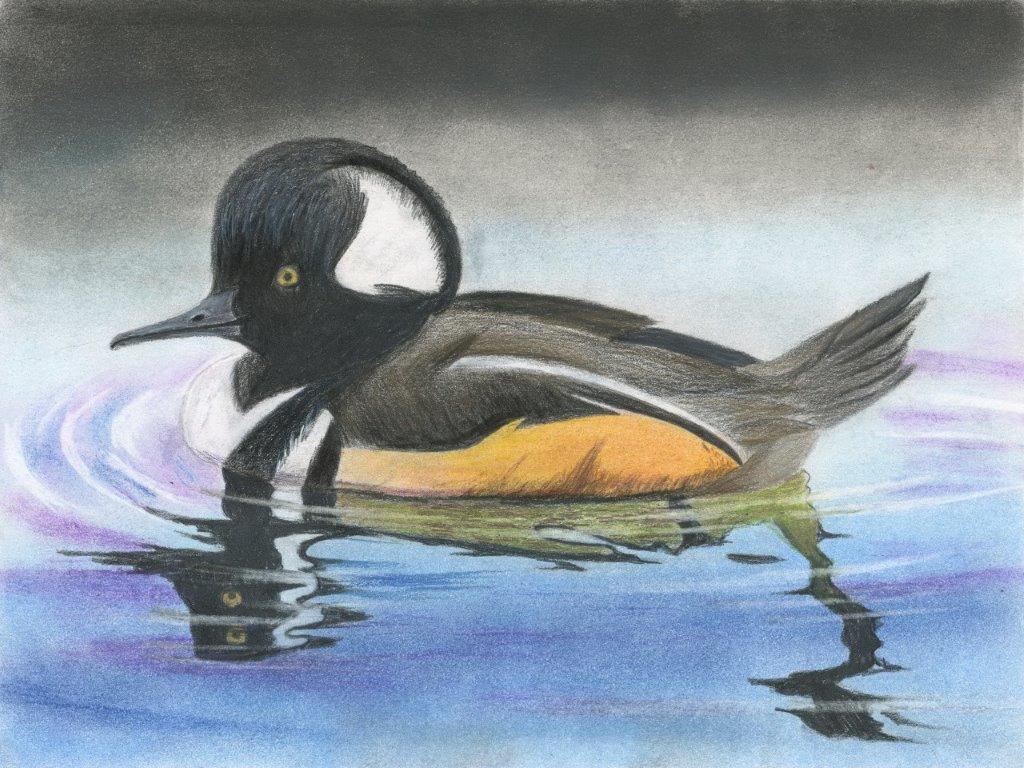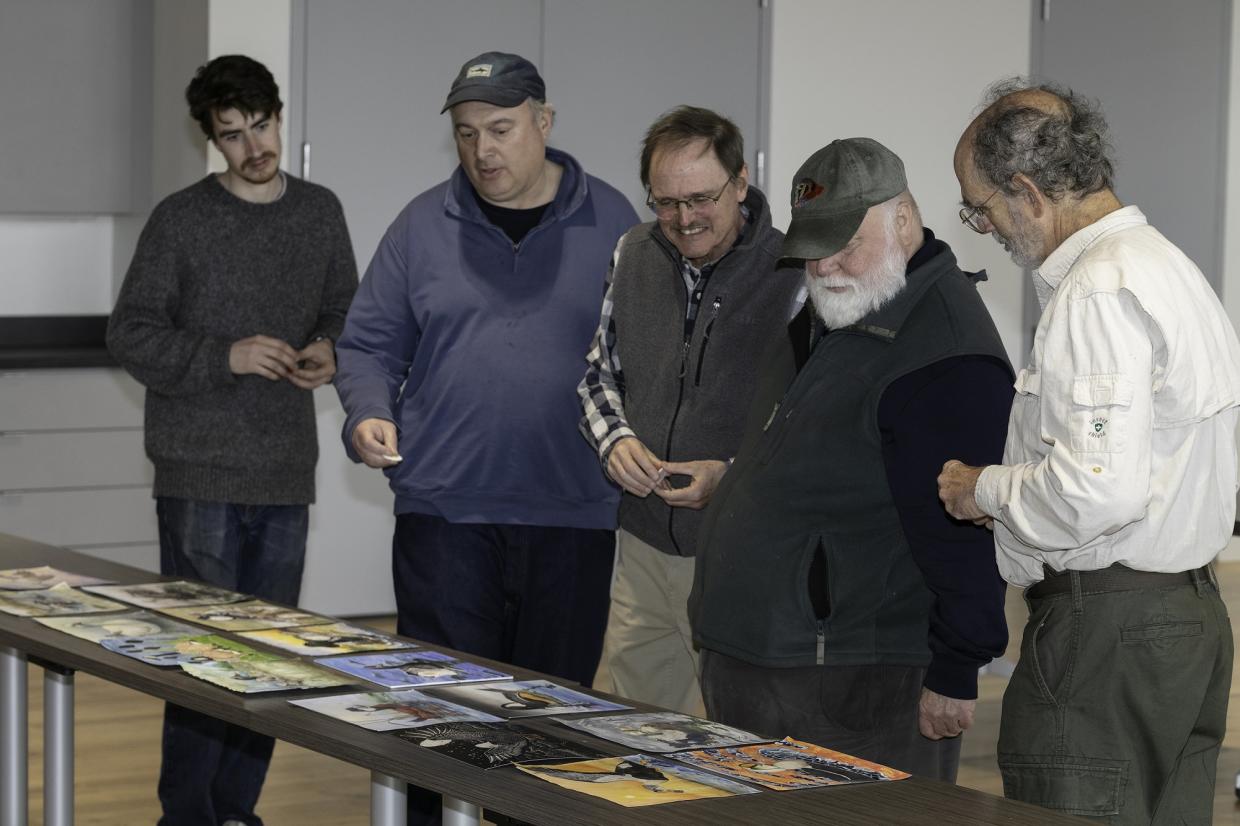- Division of Fisheries and Wildlife
Media Contact for Youth Artist from Acton Wins Junior Duck Stamp Contest
Media Contact, MassWildlife

Meghan Li from Acton won Best of Show in the 2024 Massachusetts Junior Duck Stamp (JDS) Contest. Her colored pencil and soft pastel drawing of a hooded merganser was selected from 267 entries. Li’s award-winning work will represent Massachusetts at the National JDS Contest.
Students from kindergarten through grade 12 from across the Commonwealth submitted original works of art depicting waterfowl in their natural habitats, demonstrating both artistic talent and a knowledge of the value of wetlands for wildlife. In March, a panel of judges selected the top works of art in each of four age groups. A combination of the top artworks will be exhibited throughout Massachusetts in the coming year; click here for the exhibit schedule.
The Massachusetts JDS Program is sponsored by MassWildlife and the U.S. Fish and Wildlife Service, with support from the Massachusetts Sportsmen’s Council. Please support the JDS Program and wetland conservation by purchasing Junior Duck Stamps featuring national winners from previous years. Stamps can be purchased at duckstamp.com.
More about the Junior Duck Stamp Program
Students who participate in the Junior Duck Stamp Program learn about waterfowl, explore waterfowl habitats, and investigate conservation challenges facing ducks, geese, and swans. These learnings are translated into works of art that show what students have discovered about the species’ anatomy and unique characteristics. Students are encouraged to illustrate aquatic vegetation, trees, and plants appropriate for the depicted species’ natural habitat. Feather colors should be appropriate to the time of the year demonstrated by the environment in the painting. To learn more about the Massachusetts JDS Program, visit mass.gov/dfw/jds.
The judging process
At the state level, it takes several rounds of judging to select winners. First, second, and third place, plus honorable mentions are awarded in each of four age categories. One student’s design is selected as “Best of Show” and represents Massachusetts at the National level. Artwork entries are judged based on originality, anatomical accuracy, artistic composition, and suitability for reproduction on a 1.5 x 2-inch stamp.
Judges consider a variety of aesthetic criteria when evaluating artwork including:
- Form: For realistic portrayals, is the waterfowl anatomically accurate? For other art styles, does the form highlight the species' characteristics in an appropriate way?
- Line: Are the details necessary, correct, and effective?
- Colors: Are the colors appropriate for the selected species and surrounding habitat? Does the illustration accurately or creatively depict the species of waterfowl in plumage, habitat, and season, in a realistic or decorative depiction of the bird or birds?
- Scale and shape: Is the visual statement appropriate for a 1.5 x 2-inch stamp, or will details be lost when reduced in size? Is the design suited to a horizontal, rectangular stamp shape?
- Clarity of visual symbolism: Does the illustration communicate the purpose of the stamp and can the elements of the illustration be easily identified?
- Spatial divisions: Are there negative and positive areas within the illustration and do they work together?
- Texture: Are the textures visually and physically appropriate to the species of waterfowl chosen?
Click here to view a selection of JDS artwork from previous years.
Meet the JDS judges
The impressive panel of Massachusetts Junior Duck Stamp judges have expertise in the arts and in the natural sciences.
Barry W. Van Dusen
Barry W. Van Dusen is an internationally recognized wildlife artist who has illustrated many books. His most recent book, Finding Sanctuary, was published by Mass Audubon in 2020. In 2014, Barry was named Master Artist at the annual Birds in Art show (Wausau, Wisconsin)—joining the ranks of Roger Tory Peterson and Robert Bateman in receiving this highest accolade for bird artists. In 1994, Barry was elected a full member of Britain’s Society of Wildlife Artists; he contributes annually to their London exhibition.
At the invitation of the Artists for Nature Foundation, Barry has traveled around the world with other wildlife artists to raise money for habitat conservation. In 2007, Barry was chosen to create the UK Habitat Conservation Stamp (the British counterpart to the US Federal Duck Stamp) and was the first American to be so honored. See more of the artist’s work at barryvandusen.com
Dave Small
Dave Small is president of the 280-member Athol Bird and Nature Club and Director of the Millers River Environmental Center in Athol. Dave shares his passion for birds, butterflies, moths, dragonflies, reptiles, and amphibians through workshops, lectures, and field trips around New England. Over the years, Dave has contributed his knowledge and time to a variety of organizations and municipal entities including Millers River Watershed Council, Mount Grace Land Conservation Trust, Mass Watershed Coalition, Mass Audubon's Important Bird Area Technical Advisory Committee, National Moth Week Science Advisory Board, Ware River Watershed Advisory Committee, Massachusetts Natural Heritage and Endangered Species Program Advisory Committee, Athol Planning Board, and Athol Conservation Commission. Working for the Commonwealth for 35 years, Dave served as Assistant Regional Director at the DCR Quabbin Reservoir before retiring in 2013.
Will Close
Will Close is an artist and educator based in Concord, MA. He channels his love of nature into his role as an outdoor education instructor at the Carroll School in Lincoln. When not teaching, Will immerses himself in the forest, rendering a wide range of species through observational illustration—from New England landscapes to the depths of the Ecuadorian Amazon. Watercolor and graphite serve as his primary mediums, though he also works in collage, assemblage, and time-based media. His work delves into the intricate relationships between all life on both local and global scales, with recent focus on documenting species in protected areas such as conservation lands and national parks. Will’s artwork has been showcased nationally and internationally, including exhibitions at venues like the United States Capital and the Academy of Fine Arts in Kolkata, India. Most recently, he was the inaugural artist in residence with the North Country Land Trust in Ashburnham, MA. View Will’s artwork at willclosestudios.com.
John Burk
John Burk is a photographer, writer, and historian who specializes in nature and landscapes of New England. He has authored or edited regional books and guides, contributed to publications, and collaborated with numerous organizations and individuals. John lives in central Massachusetts.

